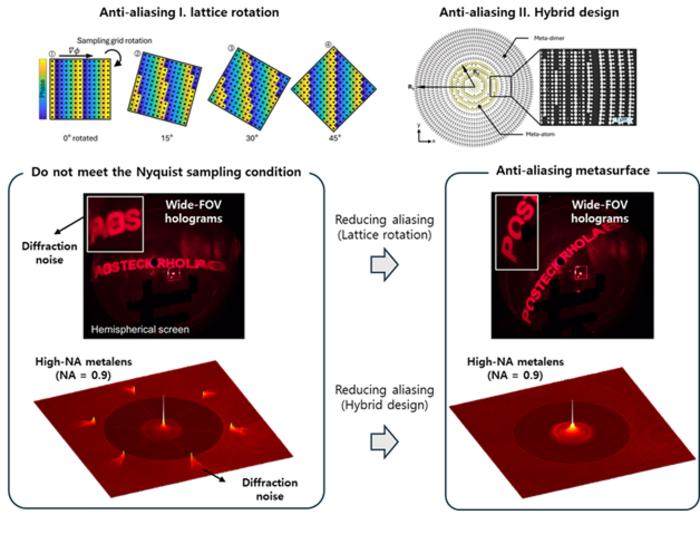
In recent years, the landscape of optical technologies has shifted dramatically with the emergence of flat optics, a revolutionary approach to manipulating light. The research team at POSTECH, under the leadership of Professor Junsuk Rho, has made a significant contribution to this field by developing a novel multidimensional sampling theory. Their findings promise to overcome longstanding challenges in metasurface design, a key area of flat optics that utilizes finely patterned nanostructures to control the propagation of light.
Flat optics, characterized by ultra-thin and lightweight surfaces, represents the next frontier in optical engineering, allowing for the creation of compact devices that outperform traditional bulky optical systems. The advantages of this technology are profound, particularly in the miniaturization of devices such as smartphone cameras and the enhancement of augmented and virtual reality technologies. In essence, flat optics holds the potential to redefine how we interact with light and the components we use to harness it.
Metasurfaces are an exciting application of flat optics, composed of countless nanostructures that enable precise manipulation of light at an unprecedented level. The challenge, however, lies in the process of sampling; this refers to the conversion of continuous optical signals into discrete data points, akin to how our brains interpret visual stimuli. Traditional sampling techniques are fraught with difficulties. If the sampling rate is insufficient, it leads to aliasing artifacts, which can create distorted images and reduce the efficiency of optical systems.
A classic example of aliasing is the wagon-wheel effect, a phenomenon observed in videos where a rotating wheel appears to spin backward. This distortion arises due to an inadequate frame rate when capturing motion. Similarly, in the context of metasurface technology, insufficient sampling can severely compromise the optical performance, necessitating a more robust approach to sampling methodologies.
Historically, researchers have leaned heavily on the Nyquist sampling theorem to guide their efforts in mitigating aliasing effects. While this theorem proves valuable in the domain of digital signal processing, the POSTECH research team uncovered critical limitations when applying it to the complexities inherent in optical metasurfaces. The Nyquist theorem defines frequency thresholds for digital systems; however, it fails to accurately account for the unique attributes of metasurfaces and the wave characteristics of light, resulting in optical distortions that diminish image quality and efficiency.
To rectify these limitations, the POSTECH team formulated a groundbreaking multidimensional sampling theory that embraces the intricate interplay between the two-dimensional lattice arrangement of metasurfaces and the wave properties of light. This innovative approach marks the first time that the geometric relationship between a metasurface’s nanostructured structure and its spectral response has been explicitly linked to enhancing optical performance.
By introducing an anti-aliasing strategy that marries lattice rotation with elemental diffraction, the researchers significantly minimized optical noise. This enhanced light control was demonstrated across various spectrum regions, from visible light to ultraviolet wavelengths. The team showcased the functionality of high-numerical-aperture metasurfaces and wide-angle meta-holograms operating specifically in the ultraviolet spectrum.
The implications of this research are not just theoretical; they open new avenues for the development of advanced optical devices. The ability to address and mitigate aliasing effects means that high-NA metalenses and wide-angle meta-holograms can be realized more effectively, pushing the boundaries of optical engineering. Professor Rho emphasizes that this new sampling theory is versatile enough to span the entire electromagnetic spectrum, including microwaves and extreme ultraviolet light, significantly lowering the fabrication hurdles typically encountered with short-wavelength ultraviolet optics.
As technology progresses, the need for precise optical components will only grow. Devices operating in the ultraviolet spectrum, for instance, require meticulous fabrication processes due to their sensitivity to manufacturing defects. By easing the underlying fabrication challenges, the research by Professor Rho and his team not only paves the way for practical applications but also encourages further exploration into the potential of ultraviolet metasurfaces, which has remained largely untapped.
Support from prominent entities such as POSCO, Samsung Electronics, the Ministry of Science and ICT, and the National Research Foundation of Korea underscores the importance of this research. Their backing highlights the vital role of collaboration between academic institutions and industry in driving innovative research to fruition.
The upcoming publication of these findings in Nature Communications serves as a testament to the rigorous validation process underlying this groundbreaking work. It sets the stage for discussions within the scientific community and encourages ongoing investigations into the nuances of optical metasurfaces and the fundamental principles governing light manipulation.
In a world increasingly dependent on technology, the potential for next-generation flat optical devices to transform industries—from consumer electronics to scientific research—is profound. As researchers tirelessly work on refining metasurface technologies, it is evident that the future of optics is not merely about enhancing existing functionalities but also about rewriting the fundamental rules of light manipulation.
The development of multidimensional sampling theory signifies a leap forward, providing a robust framework for designing advanced optical systems that ensure high efficiency and precision. As we continue to unravel the complexities associated with waves and light, the applications of this research promise to enhance the capabilities of various technologies critical to communication, imaging, and beyond.
In conclusion, the collaborative effort between researchers and institutions has shed light on the significant challenges within optics while also illuminating potential pathways for innovation. The future of flat optics, particularly through the lens of improved metasurface design, is an exciting domain ripe for exploration, promising advancements that could revolutionize our interaction with light in the years to come.
Subject of Research: Advanced Metasurface Design through Multidimensional Sampling Theory
Article Title: Anti-aliased metasurfaces beyond the Nyquist limit
News Publication Date: 6-Jan-2025
Web References: http://dx.doi.org/10.1038/s41467-024-55095-z
References: Nature Communications
Image Credits: Credit: POSTECH
Keywords
Flat optics, Metasurfaces, Sampling theory, Optical technology, Ultraviolet optics, Antialiasing strategy, Image distortion, Optical efficiency, Light manipulation, Nanostructures, High-numerical-aperture metalenses, Optical performance.
Tags: augmented reality opticscompact optical devicesflat optics technologyfuture of light-based deviceslight manipulation techniquesmetasurface design challengesmultidimensional sampling theorynanostructured optics applicationsoptical engineering breakthroughsPOSTECH research innovationssmartphone camera advancementsvirtual reality technology enhancements





